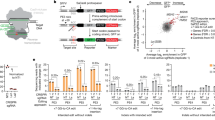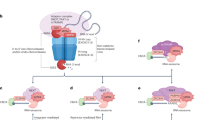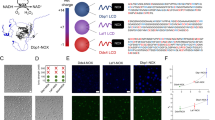Abstract
Negative-sense RNA viruses, such as influenza, encode large, multidomain RNA-dependent RNA polymerases that can both transcribe and replicate the viral RNA genome1. In influenza virus, the polymerase (FluPol) is composed of three polypeptides: PB1, PB2 and PA/P3. PB1 houses the polymerase active site, whereas PB2 and PA/P3 contain, respectively, cap-binding and endonuclease domains required for transcription initiation by cap-snatching2. Replication occurs through de novo initiation and involves a complementary RNA intermediate. Currently available structures of the influenza A and B virus polymerases include promoter RNA (the 5′ and 3′ termini of viral genome segments), showing FluPol in transcription pre-initiation states3,4. Here we report the structure of apo-FluPol from an influenza C virus, solved by X-ray crystallography to 3.9 Å, revealing a new ‘closed’ conformation. The apo-FluPol forms a compact particle with PB1 at its centre, capped on one face by PB2 and clamped between the two globular domains of P3. Notably, this structure is radically different from those of promoter-bound FluPols3,4. The endonuclease domain of P3 and the domains within the carboxy-terminal two-thirds of PB2 are completely rearranged. The cap-binding site is occluded by PB2, resulting in a conformation that is incompatible with transcription initiation. Thus, our structure captures FluPol in a closed, transcription pre-activation state. This reveals the conformation of newly made apo-FluPol in an infected cell, but may also apply to FluPol in the context of a non-transcribing ribonucleoprotein complex. Comparison of the apo-FluPol structure with those of promoter-bound FluPols allows us to propose a mechanism for FluPol activation. Our study demonstrates the remarkable flexibility of influenza virus RNA polymerase, and aids our understanding of the mechanisms controlling transcription and genome replication.
This is a preview of subscription content, access via your institution
Access options
Subscribe to this journal
Receive 51 print issues and online access
$199.00 per year
only $3.90 per issue
Buy this article
- Purchase on Springer Link
- Instant access to full article PDF
Prices may be subject to local taxes which are calculated during checkout




Similar content being viewed by others
References
Ortín, J. & Martin-Benito, J. The RNA synthesis machinery of negative-stranded RNA viruses. Virology 479–480, 532–544 (2015)
Fodor, E. The RNA polymerase of influenza a virus: mechanisms of viral transcription and replication. Acta Virol. 57, 113–122 (2013)
Pflug, A., Guilligay, D., Reich, S. & Cusack, S. Structure of influenza A polymerase bound to the viral RNA promoter. Nature 516, 355–360 (2014)
Reich, S. et al. Structural insight into cap-snatching and RNA synthesis by influenza polymerase. Nature 516, 361–366 (2014)
Muraki, Y. & Hongo, S. The molecular virology and reverse genetics of influenza C virus. Jpn. J. Infect. Dis. 63, 157–165 (2010)
Gabriel, G. & Fodor, E. Molecular determinants of pathogenicity in the polymerase complex. Curr. Top. Microbiol. Immunol. 385, 35–60 (2014)
Cianci, C., Tiley, L. & Krystal, M. Differential activation of the influenza virus polymerase via template RNA binding. J. Virol. 69, 3995–3999 (1995)
Rao, P., Yuan, W. & Krug, R. M. Crucial role of CA cleavage sites in the cap-snatching mechanism for initiating viral mRNA synthesis. EMBO J. 22, 1188–1198 (2003)
Chang, S. et al. Cryo-EM structure of influenza virus RNA polymerase complex at 4.3 Å resolution. Mol. Cell 57, 925–935 (2015)
Kawaguchi, A. & Nagata, K. De novo replication of the influenza virus RNA genome is regulated by DNA replicative helicase, MCM. EMBO J. 26, 4566–4575 (2007)
Paterson, D. & Fodor, E. Emerging roles for the influenza A virus nuclear export protein (NEP). PLoS Pathog. 8, e1003019 (2012)
York, A., Hengrung, N., Vreede, F. T., Huiskonen, J. T. & Fodor, E. Isolation and characterization of the positive-sense replicative intermediate of a negative-strand RNA virus. Proc. Natl Acad. Sci. USA 110, E4238–E4245 (2013)
Area, E. et al. 3D structure of the influenza virus polymerase complex: Localization of subunit domains. Proc. Natl Acad. Sci. USA 101, 308–313 (2004)
Arranz, R. et al. The structure of native influenza virion ribonucleoproteins. Science 338, 1634–1637 (2012)
Coloma, R. et al. The structure of a biologically active influenza virus ribonucleoprotein complex. PLoS Pathog. 5, e1000491 (2009)
Moeller, A., Kirchdoerfer, R. N., Potter, C. S., Carragher, B. & Wilson, I. A. Organization of the influenza virus replication machinery. Science 338, 1631–1634 (2012)
Morin, B., Kranzusch, P. J., Rahmeh, A. A. & Whelan, S. P. J. The polymerase of negative-stranded RNA viruses. Curr. Opin. Virol. 3, 103–110 (2013)
Gerlach, P., Malet, H., Cusack, S. & Reguera, J. Structural insights into Bunyavirus replication and its regulation by the vRNA promoter. Cell 161, 1267–1279 (2015)
Bieniossek, C., Imasaki, T., Takagi, Y. & Berger, I. MultiBac: expanding the research toolbox for multiprotein complexes. Trends Biochem. Sci. 37, 49–57 (2012)
Walter, T. S. et al. A procedure for setting up high-throughput nanolitre crystallization experiments. I. Protocol design and validation. J. Appl. Crystallogr. 36, 308–314 (2003)
Walter, T. S. et al. A procedure for setting up high-throughput nanolitre crystallization experiments. Crystallization workflow for initial screening, automated storage, imaging and optimization. Acta Crystallogr. D 61, 651–657 (2005)
Winter, G., Lobley, C. M. C. & Prince, S. M. Decision making in xia2. Acta Crystallogr. D 69, 1260–1273 (2013)
Otwinowski, Z. & Minor, W. Processing of X-ray diffraction data collected in oscillation mode. Methods Enzymol. 276, 307–326 (1997)
Sheldrick, G. M. Experimental phasing with SHELXC/D/E: combining chain tracing with density modification. Acta Crystallogr. D 66, 479–485 (2010)
Adams, P. D. et al. PHENIX: a comprehensive Python-based system for macromolecular structure solution. Acta Crystallogr. D 66, 213–221 (2010)
Mccoy, A. J. et al. Phaser crystallographic software. J. Appl. Crystallogr. 40, 658–674 (2007)
Emsley, P. & Cowtan, K. Coot: model-building tools for molecular graphics. Acta Crystallogr. D 60, 2126–2132 (2004)
Bricogne, G. et al. BUSTER version 2.11.5 (Global Phasing Ltd., 2011)
Murshudov, G. N. et al. REFMAC5 for the refinement of macromolecular crystal structures. Acta Crystallogr. D 67, 355–367 (2011)
Nicholls, R. A., Long, F. & Murshudov, G. N. Low-resolution refinement tools in REFMAC5. Acta Crystallogr. D 68, 404–417 (2012)
Pettersen, E. F. et al. UCSF Chimera–a visualization system for exploratory research and analysis. J. Comput. Chem. 25, 1605–1612 (2004)
Stuart, D. I., Levine, M., Muirhead, H. & Stammers, D. K. Crystal-structure of cat muscle pyruvate-kinase at a resolution of 2.6 A. J. Mol. Biol. 134, 109–142 (1979)
Brownlee, G. G., Fodor, E., Pritlove, D. C., Gould, K. G. & Dalluge, J. J. Solid phase synthesis of 5′-diphosphorylated oligoribonucleotides and their conversion to capped m7Gppp-oligoribonucleotides for use as primers for influenza A virus RNA polymerase in vitro. Nucleic Acids Res. 23, 2641–2647 (1995)
Chung, T. D. et al. Biochemical studies on capped RNA primers identify a class of oligonucleotide inhibitors of the influenza virus RNA polymerase. Proc. Natl Acad. Sci. USA 91, 2372–2376 (1994)
Deng, T., Sharps, J. L. & Brownlee, G. G. Role of the influenza virus heterotrimeric RNA polymerase complex in the initiation of replication. J. Gen. Virol. 87, 3373–3377 (2006)
Crescenzo-Chaigne, B., Naffakh, N. & van der Werf, S. Comparative analysis of the ability of the polymerase complexes of influenza viruses type A, B and C to assemble into functional RNPs that allow expression and replication of heterotypic model RNA templates in vivo . Virology 265, 342–353 (1999)
Fodor, E. et al. A single amino acid mutation in the PA subunit of the influenza virus RNA polymerase inhibits endonucleolytic cleavage of capped RNAs. J. Virol. 76, 8989–9001 (2002)
Biswas, S. K. & Nayak, D. P. Mutational analysis of the conserved motifs of influenza A virus polymerase basic protein 1. J. Virol. 68, 1819–1826 (1994)
Dias, A. et al. The cap-snatching endonuclease of influenza virus polymerase resides in the PA subunit. Nature 458, 914–918 (2009)
Guilligay, D. et al. The structural basis for cap binding by influenza virus polymerase subunit PB2. Nature Struct. Mol. Biol. 15, 500–506 (2008)
Yuan, P. et al. Crystal structure of an avian influenza polymerase PAN reveals an endonuclease active site. Nature 458, 909–913 (2009)
Fechter, P. et al. Two aromatic residues in the PB2 subunit of influenza A RNA polymerase are crucial for cap binding. J. Biol. Chem. 278, 20381–20388 (2003)
Krissinel, E. & Henrick, K. Inference of macromolecular assemblies from crystalline state. J. Mol. Biol. 372, 774–797 (2007)
Karplus, P. A. & Diederichs, K. Linking crystallographic model and data quality. Science 336, 1030–1033 (2012)
Rice, P., Longden, I. & Bleasby, A. EMBOSS: The European molecular biology open software suite. Trends Genet. 16, 276–277 (2000)
Acknowledgements
We thank N. Naffakh for providing plasmids and I. Berger for providing us with the MultiBac system. The authors thank Diamond Light Source for beamtime (proposal mx8423), and the staff of the MX beamlines for assistance. K. Harlos also provided valuable technical assistance. We thank G. G. Brownlee for initiating this project and for his comments and continuous encouragement, and members of the Fodor, Grimes and Stuart laboratories, particularly A. te Velthuis, for discussions. This work was supported by Medical Research Council (MRC) grants MR/K000241/1 (to E.F.), G1100138 (to F.T.V.) and G1000099 (to D.I.S.), Wellcome Trust Studentship 092931/Z/10/Z (to N.H.), an MRC Studentship (to I.S.M.), and Wellcome Trust administrative support grant 075491/Z/04.
Author information
Authors and Affiliations
Contributions
N.H., F.T.V., D.I.S., J.M.G. and E.F. conceived and designed the study. N.H., K.E.O., I.S.M. and R.P.R. performed experiments. S.C. provided coordinates before publication and discussed the results. C.V. and G.B. aided with data analysis and provided valuable advice. N.H., F.T.V., K.E.O., R.P.R., D.I.S., J.M.G. and E.F. analysed data and wrote the paper.
Corresponding authors
Ethics declarations
Competing interests
The authors declare no competing financial interests.
Extended data figures and tables
Extended Data Figure 1 Purification and characterization of FluPolC.
a, Elution profile of FluPolC, after affinity purification over IgG-sepharose, from a size-exclusion chromatography column. Eluted protein was detected by measuring the absorbance at 280 nm. b, Fractions corresponding to the major peak eluting from the size-exclusion chromatography column were mixed and analysed by SDS–PAGE on a 15% polyacrylamide gel, alongside the indicated molecular mass markers. Protein was visualized by Coomassie blue staining (PB1, 86.0 kDa; PB2, 87.2 kDa; P3, 81.9 kDa). c, Transcription and replication initiation assays. Lanes 2–6 test for transcription initiation. With the addition of vRNA promoter only (lanes 4 and 5), FluPolC can cleave a capped and radiolabelled 20-nucleotide RNA, demonstrating promoter-dependent endonuclease activity. Lane 6 shows that with the addition of NTPs, this capped primer can be extended to produce a capped transcript, thus demonstrating transcription initiation activity. This result is confirmed by lanes 7–9, which test for extension of a capped and radiolabelled 11-nucleotide RNA primer. Extension only takes place when the polymerase is supplied with NTPs and promoter RNA (lane 9). Lanes 10–12 assay for replication initiation. Lane 12 shows that FluPolC (400 ng per reaction) is able to synthesize ApG dinucleotide in a primer-independent manner. This demonstrates de novo replication initiation activity. Uncapped 20-nucleotide and 11-nucleotide primers are used as size markers in lane 1. The slow migration of the ApG dinucleotide compared to the markers is due to the lack of phosphate groups on the 5′ end of this product35. d, De novo initiation and elongation assay. FluPolC (800 ng) was incubated for 3 h with NTPs, [α-32P]GTP and 5′ or 3′ vRNA promoter strands, as indicated. In the presence of both promoter strands (lane 4), FluPolC is able to produce a full-length copy of the template (14 nucleotides, corresponding to the major band), demonstrating de novo replication initiation and elongation activity. The minor slower and faster bands may correspond to non-templated extension and premature termination products, respectively.
Extended Data Figure 2 Data and model quality.
Plots of CC*, CCfree and CCwork against resolution, for the tetragonal crystal data set and model. The CC* statistic assesses the signal present in the data, while CCfree and CCwork provide an estimate of the agreement between data and model. A CC* value of 0.87 for the highest resolution shell indicates that these data contain useful information up to 3.9 Å. CCfree and CCwork are lower than CC*, showing that the model does not overfit the data.
Extended Data Figure 3 Functional and structural relationships of FluPolC.
a, Effect of amino acid mutations in FluPolC on transcription and replication. Plasmids to express FluPolC subunits and NP along with a plasmid expressing a negative-sense CAT reporter gene flanked by the terminal non-coding sequences of the influenza C virus NS gene segment36 were transfected into 293T cells (ATCC). Total RNA was isolated using Trizol (Invitrogen) 30 h post transfection and viral RNAs were analysed by primer extension37 using the following primers: 5′-CGCAAGGCGACAAGGTGCTGA-3′ (for detection of vRNA, yielding a 127-nucleotide product) and 5′-ATGTTCTTTACGATGCGATTGGG-3′ (for detection of mRNA and complementary RNA (cRNA), yielding 98–102-nucleotide and 89-nucleotide products, respectively). Primer extension products were analysed by 6% PAGE. Quantification of primer extension analysis using phosphorimaging is shown below. The mean and s.d. of three experiments are shown. Asterisks indicate a significant difference from wild type (WT), which was set to 100% (*P < 0.05; **P < 0.01, based on a two-sample t-test). A double mutation of two aspartic acids Asp446/Asp447, that align with Asp445/Asp446 of influenza A virus PB1 found to be critical for activity38, resulted in no detectable activity in the context of FluPolC. Mutation of amino acid residues in the PB2 cap-binding and P3 endonuclease domains that align with critical amino acid residues in FluPolA39,40,41 resulted in undetectable accumulation of viral mRNA although most of these mutants were still able to replicate. The exception was Phe416Ala in PB2 that inhibited both transcription and replication, suggesting that this mutation might not only affect cap-binding but overall PB2 folding, in agreement with previously observed inhibitory effects of mutations in the cap-binding domain on replication42. The requirement of these amino acid residues for mRNA synthesis is consistent with the hypothesis that FluPolC generates capped RNA primers for transcription initiation in a manner similar to that of FluPolA. b, Structure-based phylogenetic tree showing the relationship of PB1 from FluPolC (C PB1) to other right-handed polymerases. Pairwise comparisons were performed using SHP32 and a phylogenetic tree constructed using PHYLIP. The branches are identified by the PDB accession code of the polymerase.
Extended Data Figure 4 New subunit interfaces in apo-FluPolC.
a, b, Two views of the interaction interface between PB2NLS (green) and P3endo (blue). Predicted polar contacts between the subunits are shown as dotted yellow lines. c, The interface between PB2cap (green) and PB1palm (orange). In all panels, residues at the interface were calculated using the ‘Protein interfaces, surfaces and assemblies’ service PISA at the European Bioinformatics Institute (http://www.ebi.ac.uk/pdbe/prot_int/pistart.html)43.
Extended Data Figure 5 SAXS analysis of FluPolC.
a, Calculated solution-state SAXS profiles for the crystal structures of vRNA-FluPolA3 (activated conformation) and apo-FluPolC (closed conformation). A distinguishing difference between these profiles is the dip at q ~ 0.1 Å−1 in the FluPolC curve. b, Solution-state SAXS profile of FluPolC, without added promoter RNA, overlaid with the calculated curve for the vRNA-FluPolA structure3. The good match between these curves suggests that in this particular buffer (0.5 M NaCl, 25 mM HEPES-NaOH, pH 7.5, 5% (v/v) glycerol), FluPolC adopts the same globular conformation as the RNA bound state. c, Dimensionless Kratky plot of apo-FluPolC in the presence of 0.5 M NaCl, 25 mM HEPES-NaOH, pH 7.5 and 5% (v/v) glycerol (blue) or 100 mM KCl, 2% (w/v) sucrose and 100 mM sodium phosphate, pH 7.3, with (magenta) or without (grey) 200 mM proline. Cross-hairs denote the Guinier–Kratky point (1.732, 1.104), the peak position for an ideal, globular particle. As indicated by the upward shift of the peaks in the dimensionless Kratky plot, FluPolC is less globular in the presence of phosphate than it is in the 0.5 M NaCl buffer. This effect can be lessened if proline is also present, potentially owing to increased molecular crowding.
Extended Data Figure 6 Differences at the 5′ vRNA promoter binding site.
Superposition of apo-FluPolC (darker colours) and FluPolA (lighter colours) structures, with sites of interest labelled.
Supplementary information
Supplementary Information
This file contains Supplementary Figure 1. (PDF 217 kb)
Conformational flexibility of FluPol
Morph between the structure of Apo-FluPolC and that of promoter-bound FluPolA (4WSB). The subunits and domains are coloured as in Fig. 2, while promoter RNA is coloured red. (MP4 4141 kb)
Changes around the promoter binding site
Zoomed in video of the same morph as in Supplementary Video 1, emphasising the changes that occur around the vRNA promoter binding site. (MP4 2702 kb)
Rights and permissions
About this article
Cite this article
Hengrung, N., El Omari, K., Serna Martin, I. et al. Crystal structure of the RNA-dependent RNA polymerase from influenza C virus. Nature 527, 114–117 (2015). https://doi.org/10.1038/nature15525
Received:
Accepted:
Published:
Issue Date:
DOI: https://doi.org/10.1038/nature15525
This article is cited by
-
Mapping inhibitory sites on the RNA polymerase of the 1918 pandemic influenza virus using nanobodies
Nature Communications (2022)
-
Conformational changes in Lassa virus L protein associated with promoter binding and RNA synthesis activity
Nature Communications (2021)
-
Ultrastructure of influenza virus ribonucleoprotein complexes during viral RNA synthesis
Communications Biology (2021)
-
Structural insights into RNA polymerases of negative-sense RNA viruses
Nature Reviews Microbiology (2021)
-
Molecular basis of host-adaptation interactions between influenza virus polymerase PB2 subunit and ANP32A
Nature Communications (2020)
Comments
By submitting a comment you agree to abide by our Terms and Community Guidelines. If you find something abusive or that does not comply with our terms or guidelines please flag it as inappropriate.



